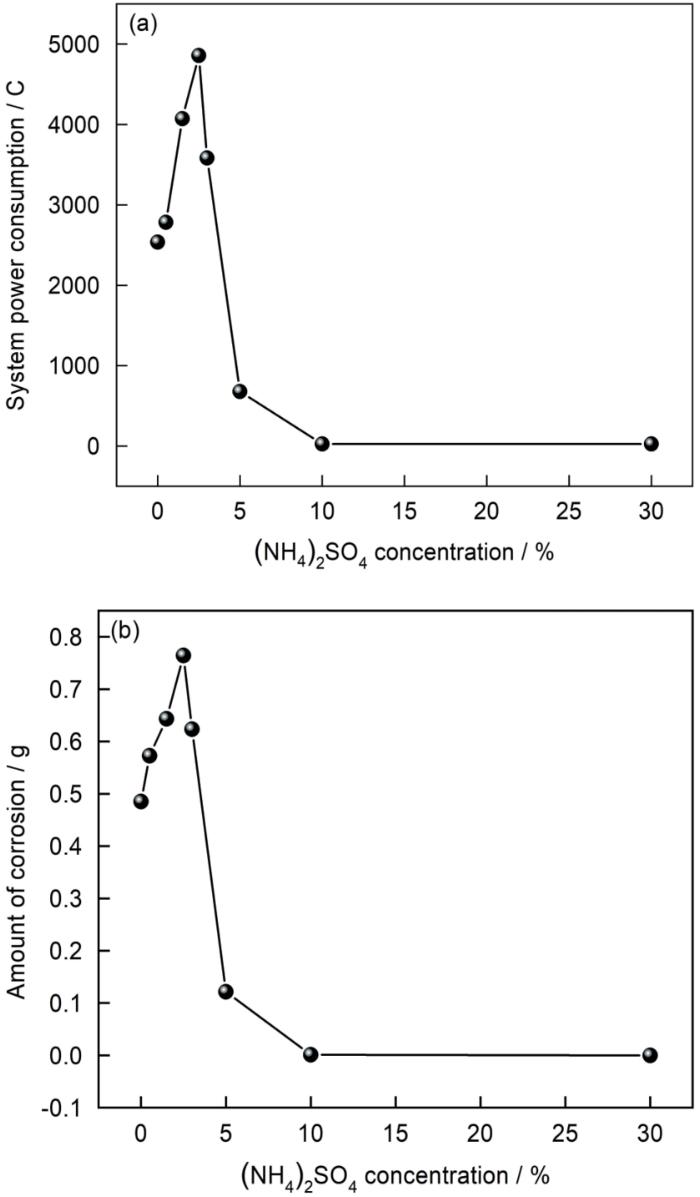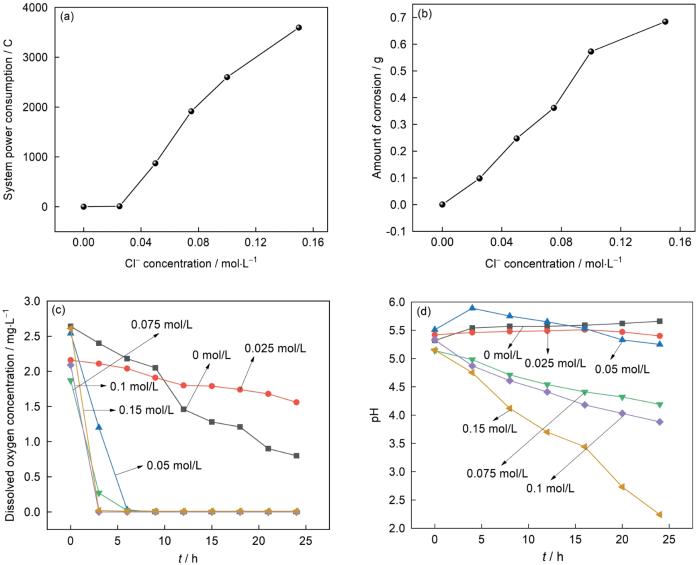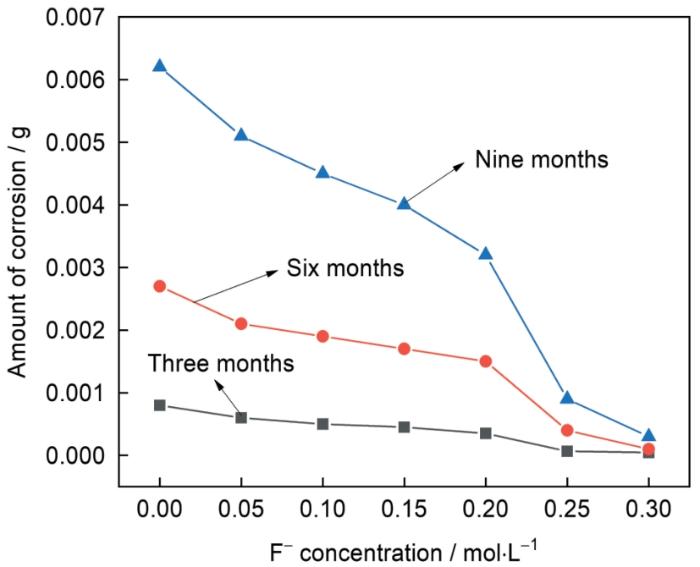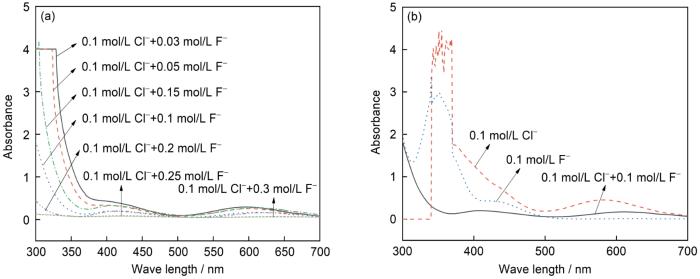因此,本研究通过恒电压模拟闭塞电池和长周期静态点蚀实验考察氨法脱硫浆液中主要成分(NH4)2SO4、Cl-、F-对304不锈钢局部腐蚀发展阶段的影响并分析其机理,以期为氨法脱硫系统的安全运行提供指导与帮助。
1 实验方法
图1为构建的局部腐蚀模拟闭塞电池的有机玻璃材质实验装置。模拟闭塞区顶部开孔插入内电极、参比电极并留有闭塞通道,闭塞通道用模拟腐蚀封堵物填充[11]。模拟闭塞区侧面设有斜插管,根据实验需要装入在线pH电极、离子选择性电极和溶解氧电极,实时监测模拟闭塞区研究参数的变化。闭塞区容积约为110 mL,外部溶液10 L。内、外电极均为304不锈钢,分别模拟局部腐蚀阳极和阴极,面积暴露比为1∶10,通过恒电位仪施加恒电压模拟阴阳极电位差,并记录电流的变化。通过对24 h内腐蚀电流随时间的变化曲线进行积分得到24 h内系统耗电量。内、外电极在实验前后均按照化学清洗法进行处理,并计算内电极的腐蚀失重,获得304不锈钢局部腐蚀发展阶段的变化[12]。
图1
图1
局部腐蚀模拟闭塞电池示意图
Fig.1
Schematic diagram of a local corrosion simulation occlusion battery
采用 Thermo ESCALAB 250XI 型X射线光电子能谱(XPS)对腐蚀产物和未被腐蚀的空白试片化学成分进行表征。表征分析前用去离子水对腐蚀样品进行充分清洗。使用紫外分光光度计分析闭塞区溶液F-、Cl-与金属离子的结合形式。
用于静态模拟点蚀实验的腐蚀试片为50 mm×25 mm×6 mm的定制304不锈钢试片。每个试片表面上钻有5个直径2 mm、深度4.5 mm的半孔以模拟点蚀坑 (如图2所示)。实验时将所研究溶液注满半孔,在半孔表面首先覆盖一层直径略大于半孔的经实验溶液预浸湿的模拟腐蚀封堵物,其成分同文献[11],然后再覆盖一层直径更大的浸湿滤纸并用环氧胶固定,用于保护模拟腐蚀封堵物。将处理好的试片置于中空玻璃支架上,放入装有研究溶液的玻璃容器内,保证溶液完全浸没试片,腐蚀一定时间后取出试片,将外层滤纸及模拟腐蚀封堵物取下。实验前后试片均按照化学清洗法进行处理,并通过滴汞法测算半孔体积的变化[13],计算试片的腐蚀失重,得到304不锈钢局部腐蚀发展阶段的变化情况。
图2
图2
304不锈钢静态模拟点蚀实验试片及装置示意图
Fig.2
Schematic diagrams of 304 stainless steel specimen and static simulation pitting test device
2 结果讨论
2.1 (NH4)2SO4 对304不锈钢局部腐蚀发展阶段的影响
图3
图3
不同硫酸铵质量分数时系统耗电量和内电极腐蚀量的变化
Fig.3
Changes in system power consumption (a) and corrosion amount of internal electrode (b) at different mass fractions of ammonium sulfate
图4
图4
不同时间304不锈钢小孔腐蚀量随硫酸铵质量分数的变化
Fig.4
Changes of pitting corrosion amount of 304 stainless steel at different mass fractions of ammonium sulfate
从图3可以看出,随着(NH4)2SO4质量分数的增加,系统耗电量、内电极腐蚀量呈现先增大后减小的趋势,在2.5%(NH4)2SO4时达到最大,这与图4长周期静态模拟点蚀实验中小孔腐蚀量随(NH4)2SO4质量分数变化的趋势基本一致。这可能是因为低质量分数的(NH4)2SO4主要起到增加溶液电导率从而加快电极表面物质交换速率的作用,腐蚀反应加速;高质量分数的(NH4)2SO4溶液含有大量的SO
2.2 Cl- 对304不锈钢局部腐蚀发展阶段的影响
图5
图5
不同Cl-浓度时系统耗电量、内电极腐蚀量、闭塞区溶解氧和pH的变化
Fig.5
Changes in system power consumption (a), internal electrode corrosion amount (b), dissolved oxygen in occlusion zone(c) and pH (d) at different Cl- concentrations
图6
图6
304不锈钢小孔腐蚀量随Cl-浓度的变化
Fig.6
Changes in the pitting corrosion amount of 304 stainless steel at different Cl- concentrations
2.3 F- 对304不锈钢局部腐蚀发展阶段的影响
图7
图7
不同F-浓度时系统耗电量、内电极腐蚀量、闭塞区pH的变化
Fig.7
Changes in system power consumption (a), corrosion amount of internal electrode (b) and pH in occlusion area (c) at different F- concentrations
表1 不同初始F-浓度时的数据对比
Table 1
| F- concentration mol·L-1 | Ionic transporting quantity /×10-3 mol·L-1 | Corrosion rate / mm·a-1 | |
|---|---|---|---|
| ΔF- | ΔCl- | ||
| 0 | 0 | 120.53 | 237.22 |
| 0.05 | -22.64 | 66.98 | 165.89 |
| 0.10 | -32.65 | 53.87 | 142.33 |
| 0.15 | -27.16 | 46.56 | 110.77 |
| 0.2 | -23.45 | 42.12 | 104.84 |
| 0.25 | 64.63 | 30.03 | 31.41 |
| 0.3 | 75.36 | 27.86 | 0.251 |
图8
图8
不同F-浓度时小孔腐蚀量的变化
Fig.8
Changes in the pitting corrosion amount of 304 stainless steel at different F- concentrations
从图7可以看出,不含F-时,系统耗电量、内电极腐蚀量最大,闭塞区pH下降幅度最大且下降速率最快;随着F-浓度的增加,系统耗电量、内电极腐蚀量逐渐减小,pH下降速率及下降幅度减弱。在F-浓度大于0.2 mol/L时,系统耗电量、内电极腐蚀量下降最为明显,F-浓度大于0.25 mol/L时,闭塞区pH变化不大,酸化效果不明显。这说明F-的存在一定程度上抑制了内电极的腐蚀,即抑制了局部腐蚀的发展。同时,恒电压模闭塞电池实验内电极的腐蚀量变化趋势与长周期静态点蚀实验中小孔腐蚀量的变化趋势 (图8) 基本一致,即通过这两种方法获得340不锈钢局部腐蚀发展趋势一致,进一步证明了F-对局部腐蚀的发展存在一定的抑制作用。
另外,从表1可知,随着F-浓度的增加,Cl-的迁移量逐渐减小,而F-的迁移量时负时正。Cl-迁移量的减小主要是因为同样带负电荷的F-的存在,二者的竞争作用影响了负电离子向闭塞区内部迁移,且随着F-浓度的增大,竞争迁移作用更为明显,所以Cl-迁移量减小,由Cl-引起的水解酸化作用减弱,减缓了腐蚀。而迁入闭塞区的F-可与内电极溶解产生的金属离子结合生成不溶的氟化物,对金属具有一定的保护作用,因此F-的存在对局部腐蚀的发展具有阻抑作用。F-迁移量的数值时负时正主要是氟氯离子的竞争迁移作用,以及形成不溶氟化物消耗F-综合作用所致。
为进一步证明F-对304不锈钢局部腐蚀发展阶段的影响,选取上述模拟闭塞电池在F-浓度为0.3 mol/L时的内电极表面腐蚀产物与未被腐蚀过的空白304不锈钢进行XPS全谱和部分元素的精细谱分析,结果如图9所示。
图9
图9
闭塞电池内部腐蚀产物XPS谱
Fig.9
XPS spectra of internal corrosion products of occlusion battery: (a) survey, (b) Fe 2p, (c) Cr 2p
2.4 闭塞电池内部溶液紫外可见光谱分析
为进一步研究脱硫浆液中氟氯离子之间的作用,分别配置不同氟氯离子含量的两组溶液,每个样品均含0.5%(NH4)2SO4,按照实验方法施加0.6 V电压24 h,对实验后闭塞区溶液进行紫外可见光吸收光谱分析,结果如图10所示。
图10
图10
闭塞闭电池实验后内部溶液紫外可见光吸收光谱
Fig.10
UV-VIS absorption spectra of internal solution after occlusion closed cell test: (a) 0.1 mol/L Cl- with different F- concentration, (b) different Cl- and F- concentration
从图10可以看出,当初始溶液分别只含0.1 mol/L F-和0.1 mol/L Cl-时,实验后闭塞区溶液在波长400 nm以下检测出两个吸收峰,应该归属于NH3与金属离子形成的络合物产生的吸收峰。当溶液中只含有Cl-时,闭塞区溶液在波长576 nm处出现一个较宽的吸收峰;当溶液中只含有F-时,闭塞区溶液在波长425 nm左右处出现了一个吸收峰[19]。当溶液中同时存在Cl-和F-时,实验后的溶液在425和576 nm处都有两个吸收峰且较单独含有Cl-或F-时的吸收峰减弱。而当初始溶液中固定Cl-浓度为0.1 mol/L,改变F-浓度时,闭塞区溶液在425和576 nm处的吸收峰随着F-浓度的升高而不断减弱。当F-浓度大于0.2 mol/L时,两个吸收峰几乎消失。结合之前的研究可以得出,闭塞区原本存在的F-以及随着实验进行迁入闭塞区的F-均可与金属离子形成络合物附着于不锈钢表面抑制腐蚀,F-浓度的增大减缓了腐蚀反应速率且与Cl-互相竞争迁移,能进入闭塞区的Cl-减少,所以检测到的两个吸收峰均减弱。
3 结论
通过恒电压模拟闭塞电池和长周期静态点蚀实验得到,氨法脱硫浆液中低浓度的(NH4)2SO4对304不锈钢局部腐蚀发展具有促进作用,高浓度的(NH4)2SO4则具有抑制作用。Cl-对不锈钢局部腐蚀具有加速作用,且随浓度的增加而加剧。F-可与腐蚀产生的金属离子形成络合物附着于不锈钢表面,且与Cl-互相竞争迁移,减少了进入闭塞区的Cl-,二者共同作用使得F-的存在对不锈钢的局部腐蚀具有一定的抑制作用。因此,可以考虑适当调节氨法脱硫浆液中(NH4)2SO4、Cl-、F-浓度来减缓不锈钢的局部腐蚀发展速率。
参考文献
Current status and challenges of atmospheric pollution prevention and control of thermal power plants in China
[J].
中国火电大气污染防治现状及挑战
[J].
Analysis and countermeasures of comprehensive advantages and existing problems of flue gas ammonia desulfurization technology
[J].
烟气氨法脱硫技术的综合优势和存在问题分析及对策
[J].
Progress of desulfurization and denitration technology of flue gas in China
[J].
Corrosion of Q235 carbon steel in ammonia-based flue gas desulfurization slurry
[J].
烟道气氨法脱硫液对Q235碳钢腐蚀研究
[J].
Effect of fluoride ion on the corrosion of 304 stainless steel in (NH4)2SO4 solution containing chloride ions
[J].
Inhibition effect of fluoride ion on corrosion of 304 stainless steel in occluded cell corrosion stage in the presence of chloride ion
[J].The role of F− in the corrosion of stainless steel at the stage of occluded cell corrosion in a mixture of chloride, fluoride, and sulfate ions was investigated. A simulated occluded corrosion cell was designed using an elaborate simulated rust layer. Composite electrodes were used to monitor the variation of the concentration of ions, pH, and dissolved oxygen of the occluded solution. The results show that the influence of F− on the corrosion of 304 stainless steel, in the occluded cell corrosion stage, is concentration dependent. When the F−/Cl− ratio is higher than 2, the corrosion can be significantly suppressed. Analyses showed that the corrosion inhibition effect could be attributed to the migration of F− to the occluded cell, which can reduce the migration of Cl−, dampen the decrease in pH, and react with metal ions to form semi-soluble products. Meanwhile, the influence of F− on the corrosion process was also verified using drilled stainless steel specimens, demonstrating the practicality and validity of the simulated occluded cell corrosion model.
Life prediction of structures suffering localized corrosion
[J].
局部腐蚀作用下设备的寿命预测
[J].
Analysis and treatment of stainless steel corrosion defect in ammonia desulfurization absorption tower
[J].
氨法脱硫吸收塔内不锈钢腐蚀缺陷分析及处理
[J].
Corrosion investigation of ammonia flue gas desulfurization (Article)
[J].
Effect of SO
SO
综述了Cl<sup>-</sup>与SO<sub>4</sub><sup>2-</sup>对奥氏体不锈钢腐蚀影响的国内外研究进展。介绍了奥氏体不锈钢的腐蚀机理,阐述了Cl<sup>-</sup>与SO<sub>4</sub><sup>2-</sup>对不锈钢腐蚀影响的原因,总结了不同研究者对SO<sub>4</sub><sup>2-</sup>具有抑制不锈钢在含Cl<sup>-</sup>溶液中腐蚀的原因,分析了不同研究者的结论存在差异的原因,并对今后的研究方向提出相应的建议。
Optimization of simulated rust layer of 304 stainless steel occluded cell in ammonia desulphurization slurry
[J].
氨法脱硫浆液中304不锈钢闭塞电池模拟锈层的优选
[J].
The influence of surface modification on corrosion behavior of 304 stainless steel in simulated nuclear power environment
[D].
表面改性对304不锈钢在模拟核电环境下腐蚀行为影响研究
[D].
Characterization of reticulated ceramic foams with mercury intrusion porosimetry and mercury probe atomic force microscopy
[J].
Corrosion research of Quinoline inhibitor for pipeline steel in simulated occluded solution
[J].
喹啉衍生物缓蚀剂对油管钢材在模拟溶液闭塞区中的腐蚀研究
[J].
stainless steel
[J].
混凝土孔隙液中Cl-浓度对304不锈钢亚稳态点蚀的影响
[J].通过动电位极化和恒电位极化研究了Cl<sup>-</sup>浓度对304不锈钢在模拟混凝土孔隙液 (pH 12.6) 中亚稳态点蚀的影响,并利用极值统计分布研究了亚稳态点蚀的峰值电流密度 (I<sub>peak</sub>),亚稳态点蚀半径 (r<sub>pit</sub>),亚稳态点蚀稳定性乘积 (I<sub>peak</sub>·r<sub>pit</sub>) 以及单个亚稳态点蚀的生长时间 (t<sub>grow</sub>),再钝化时间 (t<sub>rep</sub>),生长率 (K<sub>grow</sub>) 和再钝化率 (K<sub>rep</sub>)。结果表明,在碱性介质中,Cl<sup>-</sup>浓度增加会促使亚稳态点蚀更易转变为稳定点蚀。
Atomic layer deposition of iron (III) oxide on zirconia nanoparticles in a fluidized bed reactor using ferrocene and oxygen
[J].
Kinetics and mechanisms for reactions of Fe (II) with iron (III) oxides
[J].
Peak fitting of the chromium 2p XPS spectrum
[J].
Crevice corrosion of stainless steel in NaCl solution-changes of anolyte and state of Cr (Ⅲ) existing within crevice
[J].
不锈钢在氯化钠水溶液中的缝隙腐蚀—缝内阳极液的变化和Cr (Ⅲ)存在的形态
[J].采用摸拟缝隙的闭塞电池研究了0Cr18Ni9Ti 奥氏体不锈钢在3%氯化钠溶液中闭塞区内溶液的变化和 Cr(Ⅲ)存在的形态。当电流通过闭塞区时,随电量的增加,溶液的 pH 值迅速下降,Cl~-离子浓集。合金元素 Cr 是导致该体系中缝内阳极液低 pH 值的主要因素。用分光光度法和电化学分析法研究了阳极液,发现 Cr(Ⅲ)是以稳定而可溶的羟氯络合物形态存在于缝内闭塞液中,没有观察到 Cr(Ⅲ)因水解而形成的难溶 Cr(OH)_3沉淀物。根据上述实验结果推断:由于 Cl~-离子在缝内不锈钢表面的特性吸附,并进一步与膜中主要成份 Cr 形成可溶性的羟氯络合物而淡钝化膜遭到破坏,从而使腐蚀加剧。















